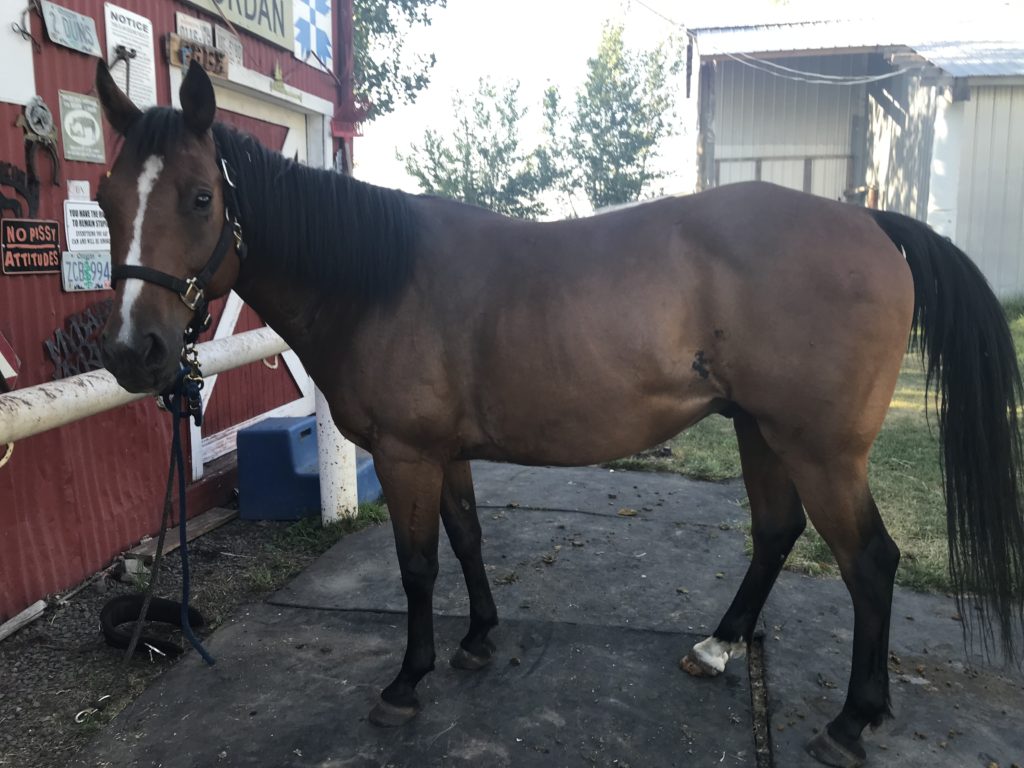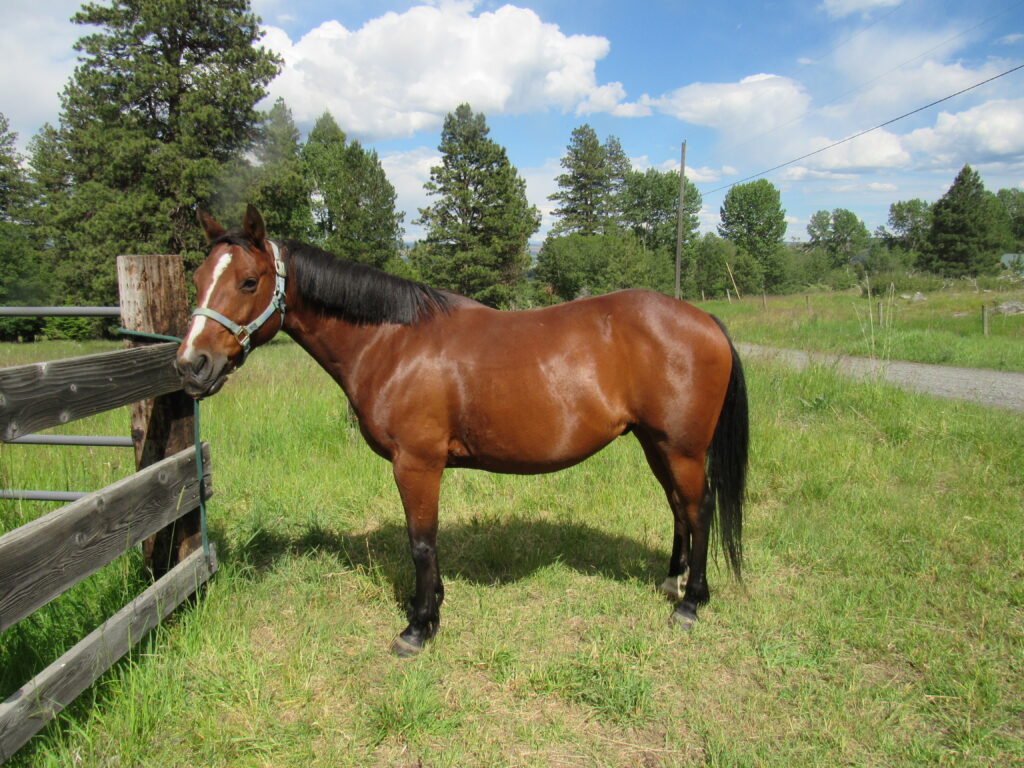I guess you could title these two photos as what a difference a year makes. In the first photo, I had no idea that I was working with a gaited horse. I just knew I had an unknown horse of unknown background, more or less, and that he desperately wanted to have his own people. Plus he had absolutely no sense of boundaries, much less that “whoa” in hand meant “stand still.”
How things change. I pulled hair on Marker about midsummer and sent it off to Texas A & M for DNA typing. I was half-expecting Morgan to come back in the mix, but what did come back was…Quarter Horse, Missouri Fox Trotter, and Tennessee Walker. A bit of reading revealed that the Walker influence is strong in the Fox Trotter breed, and that there are some who are crossing QHs with Fox Trotters. As a result, I suspect that this is what Marker is–QH x Fox Trotter. His temperament matches that of Fox Trotters, for the most part, but where I see the huge influence of Fox Trotter? Under saddle work.
It’s probably a good thing that I had nearly a year’s worth of riding on the boy before I learned about this mix. I knew he needed to come into condition, but had no idea about his past training or anything along those lines. So I followed my training instincts, honed by nearly 28 years around assorted professional trainers. I’ve never been particularly wedded to any one training school of thought but have taken in bits and pieces that seem to fit what each horse I’m riding needs. I figured out pretty quickly that Marker needed conditioning before I moved up to canter with him, and noticed that not only was he inclined to swap leads easily on the lunge line (which can also be a sign that the horse needs to work on building strength) as well as under saddle, but that he had a lot of problems picking up leads, period. Plus he needed to work on seat and leg aids, accepting contact, and comfort with a rider who uses seat as well as hand and voice.
All of that takes time. That plus I wanted to expose him to Life while under saddle, so…we spent a lot of time on gravel roads just schooling, working on contact and aids in the snaffle bit while exposing him to Scary Stuff. As his trust in me grew, I became able to talk him past things that worried him. I also noticed that while he Saw Things, he was much less reactive to them and more likely to check in with me about “is this something scary?”
But then there was the gait. Once we moved into the Western saddle, it became clear that what I thought was a smooth jog was some sort of easy gait that wasn’t walking or trotting. And that he really, really liked doing it. But the real “AHA!” moment was when we went to push some fence-creeping calves back into their field, and he lined out after them in a big fast trot. Mocha would have gone into a gallop but…he was really covering ground with that trot. Hmm. I pulled hair, got the results, and decided it was time to find out what, if anything, I needed to do differently in training him further. The gaitedness explained why he might have some cantering issues–amongst other things, once I started reading, I realized that it was harder for him to pick up a good canter from his easy gait, which I think is fox trot. That gaited horses do better when you ask them to canter from a walk, reversing what’s typical with a non-gaited horse, where canter from walk is harder than canter from trot or, in Marker’s case, from an easy gait.
Meanwhile, as it turns out, my focus on just riding while developing contact and responsiveness to leg and seat as well as voice and hand was just the thing to do. I had figured that he was ready to move up to a curb bit by midsummer, but that the bits I had weren’t going to work for him. Searches online didn’t turn up the bit I wanted, which was a loose jaw medium port curb with a copper roller that had snaffle loops as well as curb rein loops, so that I could turn it into a Western Pelham. As it turned out, I found it in the local feed store, on sale, and that I should have been looking for it under a different name. Not that it mattered. I started him out in the curb with two sets of reins for a week or so, but moved him on to one set of reins and neck reining. He’s making great progress at this level. We’ve edged into doing short canter pieces, per what I’ve been reading from experienced gaited horse trainers, but I’m holding off on big stuff until we can do more work on the flat. Right now this work happens in a sloped pasture field.
Under saddle work isn’t the only place where he’s showing improvement. Last summer he was very pushy at the gate, very pushy when being handled, and had issues with standing still on a ground tie when given the whoa command. We made some progress on this throughout the winter with the guidance of the old Mocha mare, but this summer when they moved away from the big herd and there were fewer distractions really gave us the time needed to focus on improving the behavior.
Now I can open the wire gate wide. Marker stands and waits for me to finish. I halter him, then halter Mocha. Lead them both out, ground tie them, then close the gate. Old Mocha has preferences about where she walks on the road, so for part of the way she walks on one side of me, then exchanges sides with Marker, then switches again before we go to the truck where I sit on the tailgate and hold their buckets while they eat their grain. These days they’ll just about automatically do the switch without me cueing them. They stand quietly next to each other for eating grain and grooming. And…Marker has learned to stand quietly. Much of that is Mocha’s influence. The old mare has always had strong opinions about proper horse behavior, and she’s been busy doing her share of the training. Sometimes just having her stand there, cock a hind leg, lower her head and drowse has had a soothing effect on him.
I’m happy with how things have gone with the training this summer. Where we go from here–well, we shall see. But it’s gonna be fun.


